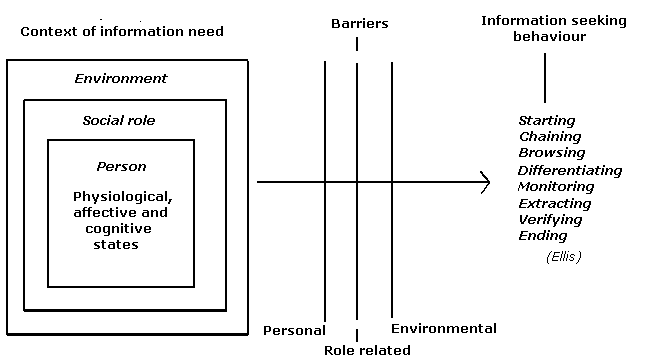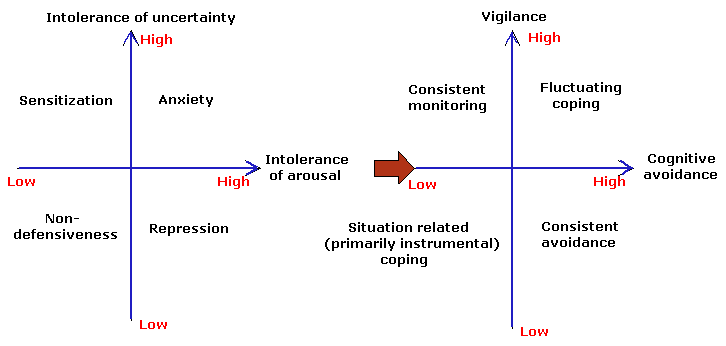
Any analysis of the literature of information-seeking behaviour must be based upon some general model of what might be called "information behaviour", of which information-seeking behaviour is a part. Wilson's (1981) model shown in Figure 1 locates the concepts of information need, information seeking, information exchange, and information use in a flow diagram that can be seen as charting the behaviour of an individual faced with the need to find information. Wilson argued that a general model of this kind was useful in identifying areas where additional research could be of value and pointed to the lack of research on information use as an example.

In the same paper Wilson proposed a model of the circumstances that give rise to information-seeking behaviour (Figure 2 - simplified for the purpose of this report). The main elements of Wilson's model are the situation within which a need for information arises (the PERSON performing a ROLE in an ENVIRONMENT), the barriers that may exist to either engaging in information-seeking behaviour or in completing a search for information successfully, and information-seeking behaviour itself. Figure 2 has been simplified and amended to show how Ellis's (1989) work on information-seeking fits into the model.

At the root of the problem of information-seeking behaviour is the concept
of information need, which has proved intractable for the reason
advanced by Wilson in 1981; that is, need is a subjective experience
which occurs only in the mind of the person in need and, consequently,
is not directly accessible to an observer.* The experience
of need can only be discovered by deduction from behaviour or through the
reports of the person in need.
The general concept of need is, of course, a psychological concept,
since it refers to a mental state or states and a good deal attention has
been given to the idea, its subjective character and the motivation for
the expression of need or the physiological drives that result in the expression
of need.
The subjective expression of need given above is evident, for example,
in a definition by Burnkrant (1976) "a cognitive
representation of a future goal that is desired".
However, in spite of the subjective nature of need, various types of
need have been defined through deduction and report. For example Morgan
& King (1971) propose that needs emerge from three kinds of motives:
physiological motives (for example, hunger and thirst)
unlearned motives (including curiosity and sensory stimulation), and
social motives (the desire for affiliation, approval or status, or aggression),
which accords with Wilson's analysis in Figure 2.
In fact, the concept of motive may be of general use in the study
of information-seeking behaviour since, if we assume that, for whatever
reason, a person experiences an information need, there must be
an attendant motive actually to engage in such behaviour. Within
the general theory of motivation it is suggested that, when a motive is
activated, a belief-value matrix within the individual is called
on. The matrix is believed to contain images of objects that past experience
has proved to be relevant for the satisfaction of the aroused need and
that different objects will have different values associated with them
relating to the believed level of success they will have in satisfying
the person's need. (Burnkrant, 1976)
The notion of motive is implicit in gratification theory (Fiske,
1990), which has been developed in mass communications research and
which assumes that an audience has complex needs that it seeks to gratify
through the use of various media. The same message, transmitted through
a medium, may be used by different individuals to gratify different needs.
The theory also suggests (Rubin, 1986) that people
are active seekers of information to gratify their needs.
McQuail (1972) suggests four main categories of
gratification, which fall mainly into what we have called affective
needs, but for which, clearly, information may have a role in gratifying:
| Diversion: | escapism, emotional release |
| Personal relationships: | companionship, social utility |
| Personal identity: | comparison with life; reality exploration; value reinforcement |
That needs may have a cognitive component (as distinct from, for example,
physiological needs such as hunger and thirst) is recognized in the concept
of the need for cognition: the need to find order and meaning in
the environment, which is also expressed as the need to know, curiosity,
the desire to be informed.
Cacioppo, et al. (1984) have devised a need for cognition scale, which has been tested not only in the USA, but also in Holland (Verplanken, et al., 1992). The present authors have considerable reservations about the usefulness of the scale, since a high degree of cognitive ability seems to be needed to complete it! However, the idea of a fundamental need which drives the search for information is seductive.
In spite of the difficulties with the concept, various categorisations
of information need have been produced. For example, Weigts,
et al. (1993) suggest the following categories:
need for new information;
need to elucidate the information held; and
need to confirm information held.
Note, however, that the focus of these types is cognitive need
and, given the significance of beliefs and values, we need
to add:
need to elucidate beliefs and values held, and
need to confirm beliefs and values held,
since information may be needed to achieve these things.
The mode of questioning in carrying out searches also identifies underlying
information needs. For example, Carter (reported in Chew,
1994) suggests that when an individual is driven to seek information
as a result of 'needing to know' three modes of questioning behaviour are
exhibited:
questions to discover what is happening ('orientation');
questions to check that the person is 'on the right track' ('reorientation'), and
questions to form an opinion or solve a problem ('construction')
To these we can add, questions to build one's knowledge of a subject,
which could be labelled 'extension'.
The literature of computing and information systems design proved to
be somewhat disappointing from the point-of-view of this review - at least
as far as it was possible to cover the literature in the time available.
The reason for this appears to be that systems designers are not so much
concerned with how information is processed but with how computers
are used. Their interest appears to be almost entirely in the area of how
the computer interfaces (screen, mouse, keyboard) can be designed to provide
the user with a more effective means of navigating the system.
Perhaps typical of the approach is that provided by Veryard (1988) who sees the problem of determining information needs as being a matter simply of augmenting the system designer's normal data analysis model. The acquisition of data on information needs is described in terms that suggest that it is unproblematical:
Interview users
Talk to the users, at various levels, individually or collectively, to discover the decision-making and control processes they are responsible for, the performance measures they use, and the needs they have for information.
and, later:
Analyse information needs
Select a representative sample of information needs for detailed analysis. Analyse each selected information need in terms of the data model.
Given the complexities of the issues revealed by research in other areas
reported in this review, one cannot help but feel that the author's conclusion
that:
Using the top-down technique outlined in this paper, each selected informtion need is decomposed so that it can be defined from the entities, relationships, and attributes in the data model.
is slightly optimistic.
As an alternative to seeking to define and gain evidence of the elusive
information need, it may prove more helpful to focus upon the proximate
causes of information-seeking behaviour, if these can be discovered. A
very general theory from psychology, which has been used in health communication
studies and other areas, is that of stress and coping. Stress
is defined as:
...a relationship between the person and the environment that is appraised
by the person as taxing or exceeding his or her resources and as endangering
his or her well-being. (Folkman, 1984)
and coping as:
...cognitive and behavioural effects to master, reduce or tolerate the
internal and external demands that are created by stressful situations.
(Folkman & Lazarus, 1985)
To use this model it will be necessary to think of 'endangering his
or her well-being' in very general terms: in other words, the threat to
well-being may be minimal in many cases and may not be conceived as such
by the person in question.
The stress/coping idea offers a useful basis for further research
on information-seeking behaviour, particularly as Miller
& Mangan (1983) note that:
...one key situational property that has consistently been found to
affect stress is whether the individual has maximal information (predictability)
or minimum information (unpredictability) about the event and its effects.
Folkman (1984) notes that coping has two major
functions: '...the regulation of emotions or distress (emotion-focused
coping) and the management of the problem that is causing the distress
(problem-focused coping). Kleiber et al. (1995)
comment that:
Problem-focused coping consists of efforts to change the actual circumstances
of an adaptational encounter, whereas emotion-focused coping involves cognitive
activities that do not alter the relationship with the environment but
do alter the way in which the person-environment relationship is perceived.
Not surprisingly, van Zuuren & Wolfs (1991) find that 'monitoring' (that is, information-seeking) correlates highly with problem-focused coping.

The relationship between information-seeking and coping is set out in
Krohne's two-dimensional model (Figure 3 below). This suggests that various
states will exist as a result of intolerance of uncertainty and
intolerance of arousal, of which, from an information-seeking behaviour
perspective, the upper two cells, representing Sensitization and
Anxiety, are most interesting. If the right hand part of the diagram
is seen as 'on top of' the left hand part, Sensitization is then
seen as giving rise to Constant monitoring (explained by the high
tendency to vigilance and the low tendency to cognitive avoidance), while
Anxiety will give rise to Fluctuating coping (because of
the high tendency to cognitive avoidance). The other parts of Figure 3
may be read in a similar way.
This brief review of stress and coping suggests that it may be a useful
part of any revised general theory of information-seeking behaviour and
could provide a theoretical basis for a great deal of research in diverse
fields. Section 5.2 includes further discussion of the relationship between
self-efficacy and coping.
REFERENCES